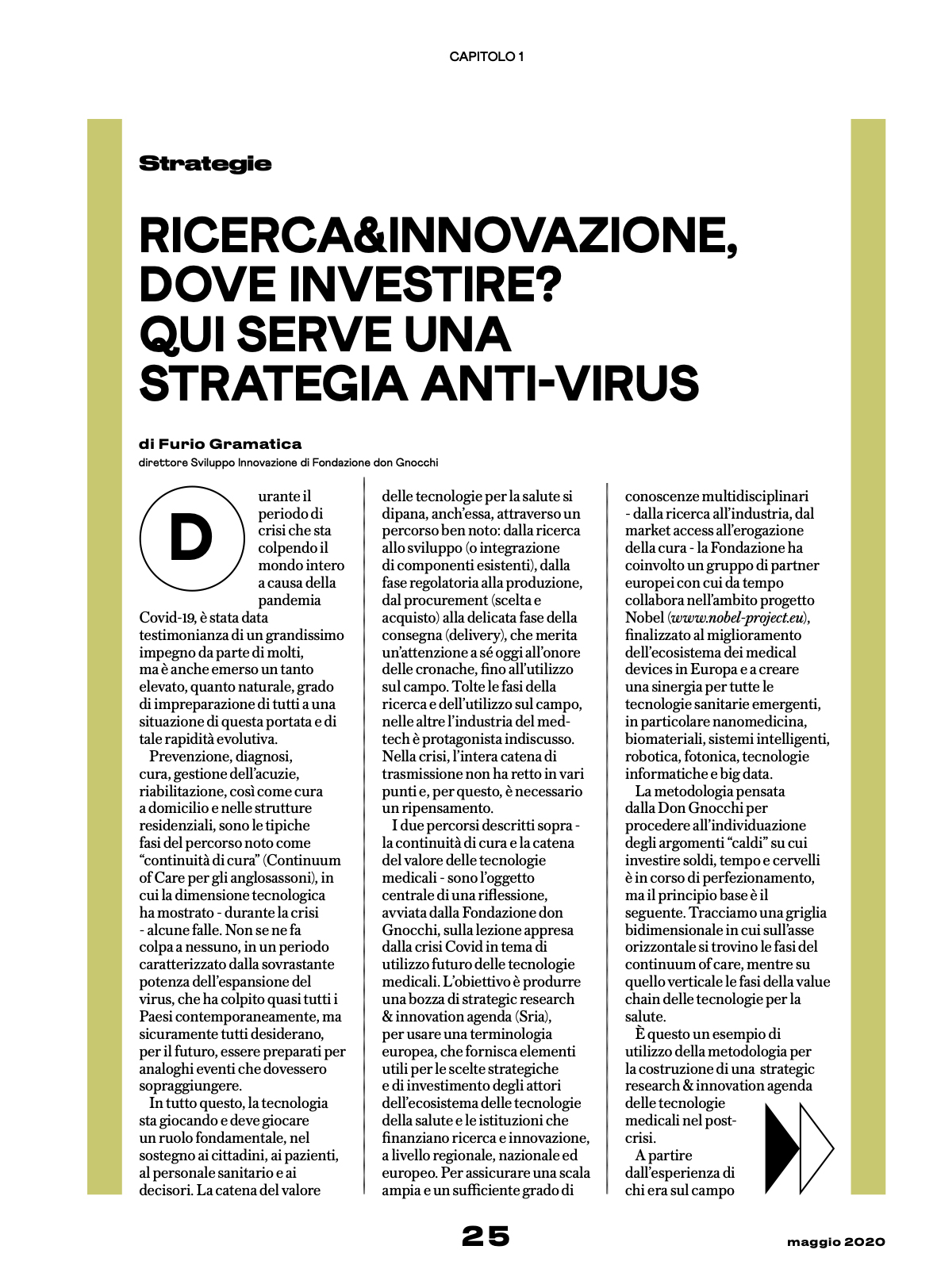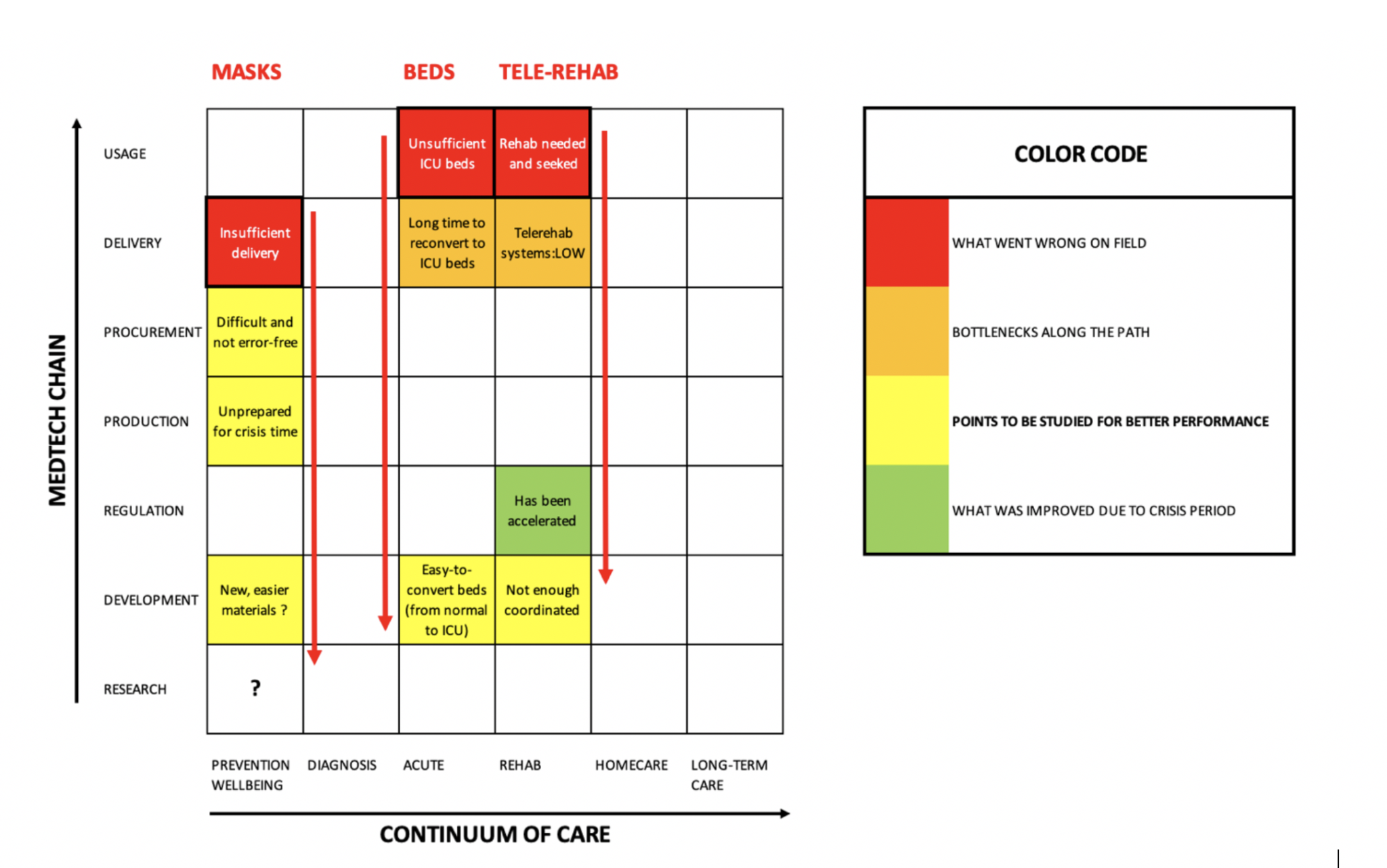The NOBEL Project, acting for a smarter use of healthtech in Europe in order to tackle complex medical challenges, is preparing a new framework for analysis and decision making following the outbreak of the coronavirus pandemic. We are happy to share with you today, as an introduction to this post-COVID19 strategic vision brought by NOBEL, an article originally published in the VITA magazine, by Dr. Furio Gramatica from Fondazione Don Gnocchi.
 In the period of crisis that is affecting the whole world due to the COVID-19 pandemic, a great commitment has been shown, but there has also emerged a high, as natural, degree of unpreparedness for everyone in a situation of this scale and of such rapid evolution.
In the period of crisis that is affecting the whole world due to the COVID-19 pandemic, a great commitment has been shown, but there has also emerged a high, as natural, degree of unpreparedness for everyone in a situation of this scale and of such rapid evolution.
Prevention, diagnosis, treatment, acute management, rehabilitation, as well as home and residential care, are the typical phases of the path known as “Continuum of Care” in which the technological dimension during the crisis has shown some flaws.
No one is to blame for this, in a period characterized by the overwhelming power of the virus expansion, striking almost all countries simultaneously, but surely everyone wants, for the future, to be prepared for similar events that should strike us.
In this framework, technology is playing and must play a fundamental role in supporting citizens, patients, healthcare professionals and decision-makers. The value chain of health technologies also unfolds through a well-known path: from research to development (or integration of existing components), from the regulatory phase to production, from procurement (choice and purchase) to the delicate phase of delivery, which deserves attention to itself today to the honor of the news, up to the use in the field. Apart from the research and the use-on-field phases, in the others the med-tech industry is the undisputed protagonist and, unfortunately, too often not listened to by decision-makers during a constant dialogue. In the crisis, the transmission chain has not held up at various points and, therefore, an afterthought is necessary.
The two paths described above – the Continuum of Care and the value chain of medical technologies – are the central object of a reflection started by the Don Gnocchi Foundation, on the lesson learned from the COVID crisis regarding the future use of medical technologies. The aim is to produce a draft “strategic research & innovation agenda (SRIA)”, to use a European terminology, which supports the strategic and investment choices of the actors of the ecosystem of health technologies and the institutions that finance research and innovation, first of all the European Commission. To ensure a large scale and a sufficient degree of multidisciplinary knowledge – from research to industry, from market access to the provision of care – the Foundation has involved a group of European partners with whom it has long collaborated in the NOBEL project (www.nobel-project.eu), aimed at improving the ecosystem of medical devices in Europe and creating a synergy for all emerging health technologies in Europe notably including nanomedicine, biomaterials, smart systems, robotics, photonics, information and computer technologies and big data.
The methodology designed by Don Gnocchi to identify the “hot” topics on which to invest money, time and brains is being perfected, but the basic principle is the following. We draw a two-dimensional grid in which the phases of the continuum of care are located on the horizontal axis, while the value chain of health technologies is on the vertical axis.

Starting from the experience of those who are on the field at the time of the crisis (and this justifies the role of initiator by a research and care institute, such as Don Gnocchi), we identify and mark in red the cells that correspond to specific difficulties found, always and only in relation to the use or availability of technologies, for example an insufficient number of personal protective equipment (“delivery” row and “prevention” column), or intensive care beds (“usage” row and “acute” column), or technologically assisted ordinary rehabilitation services (“usage” row and “rehabilitation” column). For each of the cells marked in red (problems in the field), we go down in the axis of the value chain of the technologies and identify – by marking them in orange – any bottlenecks along the production chain. With reference to them, going further down, we come to the actions for which a multidisciplinary study supplement, investment and innovation could lead to greater solidity even in times of crisis. We will mark these boxes in yellow and they will be the cornerstones of our strategic agenda, also becoming the potential topics for future research and development calls (also managerial / organizational, as well as technological / clinical). For example, the search for simpler, usable, low-cost and easily scalable production materials for personal protective equipment; or application of PCP / PPI calls (pre-commercial procurement and public procurement for innovation) aimed at designing easily convertible beds in intensive care. Or, finally, greater coordination for the integration of tele-collaboration tools to create tele-rehabilitation solutions, in order to reach patients at home, in times of confinement, and to maintain the pace of their recovery, sometimes crucial.
On top of improving our ability to answer a future crisis through strategic planning at each phase of the Continuum of Care, the existence by itself of such a continuity involves that improving one step will have a potential positive impact on all the downstream steps. For all these reasons there is crucial need for such an agenda, as a framework for smarter use of the unique value of health technologies to tackle complex medical challenges.
by Furio Gramatica
Director of Innovation Development, Don Gnocchi Foundation – NOBEL Project
